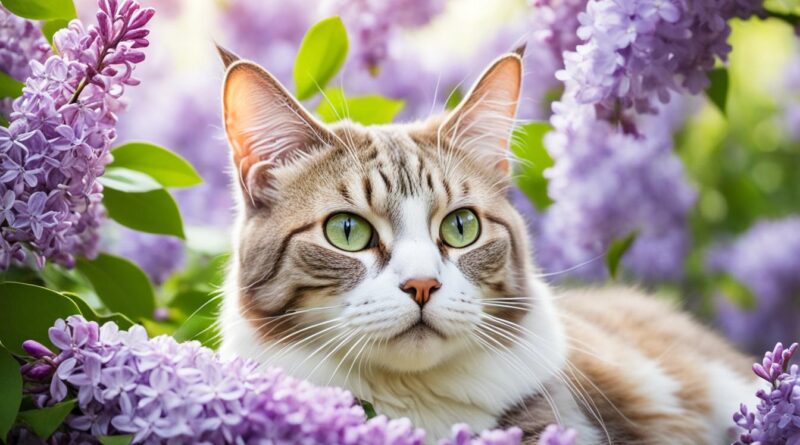Are Lilacs Safe? Cat Toxicity Concerns Unveiled
Lilacs are beautiful flowers that bring vibrant colors and a sweet fragrance to gardens and homes. If you’re a cat owner, you may be wondering if lilacs are safe for your feline friend. In this article, we will explore the potential toxicity of lilacs for cats and provide important information to help you keep your pet safe.
While common lilac plants, such as the Syringa vulgaris variety, are generally not poisonous or toxic to cats, there are certain lilac species that can be harmful if consumed in large quantities. Persian lilacs, also known as chinaberry trees, and French lilacs contain substances that can cause serious illness in cats. It is crucial to be aware of the specific variety of lilac and take precautions to ensure your cat’s safety.
Key Takeaways:
- Common lilacs, like Syringa vulgaris, are generally safe for cats.
- Persian lilacs (chinaberry trees) and French lilacs can be toxic to cats if ingested.
- Certain parts of the lilacs, such as stems and leaves, can pose a risk to feline health.
- Monitor your cat’s behavior around lilacs and prevent them from ingesting any parts of the plant.
- Choose non-toxic lilac varieties and seek veterinary attention if any symptoms of poisoning arise.
Lilacs and Cat Attraction
Cats are naturally curious creatures and may be attracted to the beauty and fragrance of lilacs. The vibrant colors and strong scent of lilac flowers may pique a cat’s interest. While lilacs themselves may not be inherently toxic to cats, it is important to remember that certain lilac species can pose a risk to feline health.
Cat owners should be cautious when allowing their cats to come into contact with lilacs, especially if they suspect the presence of toxic lilac varieties. Monitoring a cat’s behavior and ensuring they do not ingest any parts of the plant can help prevent potential health issues.

Lilacs are visually appealing and their fragrance can be enticing to cats, but it is crucial to prioritize their safety. Being aware of the potential dangers of toxic lilacs can help cat owners create a cat-friendly environment while minimizing the risk of feline toxicity.
Toxicity of Lilac Parts
While the blooms of lilac plants are generally considered safe for cats, it is important to be aware of the potential dangers associated with other parts of the plant. Some parts of lilacs can be toxic to cats and may pose a risk to their health.
Lilac Stems: The stems of lilac plants are more likely to cause choking in cats. It is advisable to keep cats away from lilac stems to prevent any accidents or harm to their well-being.
Lilac Leaves: Certain lilac species have leaves that contain a higher concentration of harmful compounds. If cats ingest lilac leaves, it can lead to various symptoms such as vomiting, diarrhea, lethargy, and even convulsions. It is crucial for cat owners to ensure that their furry companions do not have access to lilac leaves to prevent any potential poisoning incidents.
Understanding the toxicity of different parts of the lilac plant is essential for maintaining the safety and well-being of cats. Taking steps to prevent cats from accessing lilac stems and leaves can help mitigate any risks associated with lilacs and cat health concerns.
Toxic Lilac Varieties
While lilacs are generally safe for cats, it’s important for cat owners to be aware of certain toxic lilac varieties that can pose a risk to their feline companions. While the common lilac (Syringa vulgaris) is considered safe for cats, there are two lilac species that should be avoided: Persian lilacs (chinaberry trees) and French lilacs.
Persian lilacs contain melia toxins A and B in their seeds, which are harmful to cats if ingested. These toxins can lead to symptoms of poisoning such as vomiting, diarrhea, drooling, tremors, and muscular spasms. It’s crucial for cat owners to be cautious when choosing lilac varieties and ensure that Persian lilacs are not present in their homes or gardens.
French lilacs, on the other hand, contain a substance called galegin. This neurotoxic and hypotensive compound can have serious health consequences for cats, including pulmonary edema, hydrothorax, and even death. Cat owners should be aware of the potential dangers posed by French lilacs and take necessary precautions to protect their feline friends.
Here’s a summary of the toxic lilac varieties:
Persian Lilacs (Chinaberry Trees): Contains melia toxins A and B in the seeds. Can cause symptoms of poisoning in cats such as vomiting, diarrhea, drooling, tremors, and muscular spasms.
French Lilacs: Contains galegin, a neurotoxic and hypotensive substance. Can lead to serious health problems in cats, including pulmonary edema, hydrothorax, and even death.
When selecting lilacs for your home or garden, always ensure that you choose non-toxic varieties that are safe for your feline companions. By being aware of the potential dangers and taking necessary precautions, you can ensure the well-being and safety of your cats.

Conclusion
In conclusion, lilacs are generally safe for cats to be around, but it is important for cat owners to be aware of the potential toxicity of certain lilac varieties. While common lilacs are not toxic to cats, Persian lilacs and French lilacs can be harmful if ingested. It is recommended that cat owners avoid planting these toxic varieties in their homes or gardens to prevent any accidental ingestion by their feline friends.
Additionally, cat owners should closely monitor their cats when around lilac plants and seek veterinary attention if any symptoms of poisoning or discomfort arise. By being informed and taking necessary precautions, cat owners can ensure the safety and well-being of their beloved pets.
FAQ
Are lilacs poisonous to cats?
Lilacs, specifically the common lilac plant (Syringa vulgaris), are generally not poisonous or toxic to cats. However, certain lilac species, such as Persian lilacs and French lilacs, can be harmful if ingested in large quantities.
Can cats be around lilacs?
Yes, cats can be around lilacs. Lilacs themselves are generally safe for cats, but precautions should be taken with certain toxic lilac varieties. It is important to monitor a cat’s behavior and prevent them from ingesting any parts of the plant.
What are the harmful effects of lilacs on cats?
Lilacs can cause gastrointestinal problems and even death in cats if consumed in large quantities. Symptoms of lilac toxicity in cats may include vomiting, diarrhea, lethargy, convulsions, and other serious health issues.
Are lilac stems and leaves toxic to cats?
While the blooms of lilac plants are generally considered safe for cats, other parts of the plant can be toxic. Lilac stems can cause choking, and some lilac leaves contain a higher concentration of harmful compounds, leading to symptoms such as vomiting, diarrhea, lethargy, and convulsions in cats.
What are some toxic lilac varieties for cats?
Persian lilacs (chinaberry trees) and French lilacs are two examples of lilac varieties that can be toxic to cats. Persian lilacs contain melia toxins A and B, which can cause vomiting, diarrhea, drooling, tremors, and muscular spasms in cats. French lilacs contain galegin, a neurotoxic and hypotensive substance that can lead to serious health problems and even death in cats.


